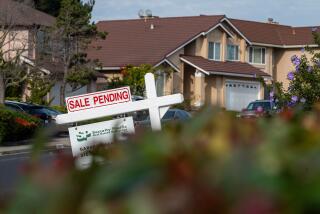Number of homes entering foreclosure plunges in California
- Share via
The number of California homes entering foreclosure plunged in the first quarter, the result of an improving economy, rising home prices and strict new state regulations on lenders.
During the year’s first three months, new foreclosure actions in the Golden State dropped 51% from the previous quarter and 67% from a year ago, the real estate firm DataQuick reported Tuesday.
The quarter’s 18,567 default notices were the fewest in more than seven years. The sharp decline coincides with state regulations on banks, meant to curb foreclosure abuses, that took effect Jan. 1. But economic factors also played a big role in the declines, experts say.
“If you were going to lose your job, you would have lost your job a long time ago,” said Richard Green, director of the USC Lusk Center for Real Estate.
Rising home values have made homeowners less likely to default by lifting many out of negative equity positions — owing more than the home is worth — and allowing them to refinance or sell.
“Anybody who can afford to avoid foreclosure is now scrambling to avoid foreclosure,” said Christopher Thornberg, principal of Beacon Economics.
The rise in prices is even luring some people once stung by foreclosure back into the market.
“I think now is the perfect time to actually buy a home,” said Donald Crabb, a 50-year-old longshoreman from Fontana who lost two homes to foreclosure when home prices tanked. “The economy, it is turning around.”
Crabb said he was nearly set to be pre-approved for a new home loan. He was hoping to find a five-bedroom property in Fontana, where he is now renting.
The hopes of Inland Empire homeowners working to keep their homes was evident Monday as a five-day homeownership event put on by the nonprofit Neighborhood Assistance Corp. of America concluded at the Ontario Convention Center. Borrowers filled a convention center hall carrying binders full of pay stubs, tax returns and other financial documents in hopes of getting NACA-brokered mortgage modifications from their lenders. Each successful modification, done on the spot, was announced on a stage and over a loudspeaker.
Abel Romo, 30, a window cleaner in Moreno Valley, said he had fallen behind on his house payments after his adjustable-rate mortgage adjusted upward. With a modification from Wells Fargo on Monday, his payments declined from $975 to $644. The extra cash will help Romo and his wife, as work for him has been scarce in recent months.
“Me and my spouse had to make hard decisions,” Romo said, “between paying the bills and paying the mortgage.”
Latreace Cox, 38, lost her job as an executive assistant at UC Riverside in 2011. She tried before to get a loan modification from Bank of America, she said, but only got a temporary payment forbearance. On Monday at the convention hall, she sat waiting in line, hoping she could get a modification lowering her payments from $2,049 to $1,600.
She had found new work at a temporary agency, she said.
“I needed to go out and get a job before they would consider a modification, which is kind of backward,” Cox said. “It’s not like I hadn’t been looking for a job.”
Several factors have put banks more in the mood to work with struggling homeowners, including a national mortgage settlement struck last year with state attorneys general. To settle allegations of foreclosure abuses, banks agreed to a $25-billion deal, which included substantial relief to troubled homeowners, including modifications and forgiveness of mortgage debt.
Lenders are increasingly turning to mortgage modifications and short sales, in which a lender allows a borrower to sell a house for less than the amount owed. In Southern California, sales of foreclosed homes last month accounted for only about 13.9% of the region’s home resales, while short sales made up an estimated 21.5%, according to DataQuick.
California’s new regulations on how banks conduct foreclosures, backed by Atty. Gen. Kamala D. Harris, also grew out of the settlement. The new law outlaws such practices as “robo-signing” — the rubber-stamping of foreclosures en masse — and “dual tracking,” or pursuing a foreclosure while the borrower is seeking a loan modification. The law also allows aggrieved borrowers and state agencies to more easily sue banks over foreclosure abuses.
“It appears last quarter’s drop was especially sharp because of a package of new state foreclosure laws — the ‘Homeowner Bill of Rights’ — that took effect Jan. 1,” DataQuick President John Walsh said in a statement. “Default notices fell off a cliff in January, then edged up.”
More to Read
Inside the business of entertainment
The Wide Shot brings you news, analysis and insights on everything from streaming wars to production — and what it all means for the future.
You may occasionally receive promotional content from the Los Angeles Times.









